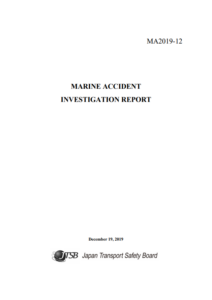While anchored in Yokohama, Keihin Port, a cargo ship dragged the anchor, drifted toward to the northeast, and collided with the seawall at Ogishima, Kawasaki section. Typhoon No. 24 was approaching. The Japan Transport Safety Board issued an investigation report on the incident.
The incident
The vessel A, with 12 crew members onboard departed from the Port of Chiba in Chiba Prefecture at around 16:30 on 29 September 2018 for the purpose of evacuating from a typhoon.
Around 18:30, the vessel brought up with 7 shackles of the chain cable of the starboard anchor up to below the water surface at Anchorage Y1 at the Keihin Port and started riding at single anchor.
At this time, Vessel B and Vessel C were being anchored about 280 m east and about 370 west of the vessel, respectively.
The master set an anchor watch from around 19:00 on 30th, and instructed that the main engine be placed on standby as the rolling and pitching of the vessel started getting large from around 22:00.
The main engine was placed completely on standby around 22:10. Around 22:15, the master recognized by radar that Vessel B and Vessel C started dragging their anchors, and the shaking of the vessel also started getting more intense.
Therefore, the master started using the main engine to avoid approaching those vessels.
Around 23:00, the master recognized that dragging of the anchors of Vessel B and Vessel C became prominent, and around 23:20, the master tried to let go the second anchor (port anchor) to prevent dragging of the anchor but could not let it go due to a failure in the windlass.
Around 00:15 on October 1st, the master recognized that Vessel B was approaching the vessel and avoided Vessel B by using the main engine and rudder.
However, during the maneuvering for this avoidance, the vessel started dragging anchor.
Therefore, the master set the main engine to full ahead but could not stop dragging of the anchor.
The vessel drifted toward the northeast, and collided with the seawall from the starboard stern around 01:47.
Around 02:00, the stern was flooded, and the vessel was hit by a strong wind and the starboard was pressed against the seawall.
All the crew of the vessel got off the vessel and landed the seawall around 02:10.
Probable causes
It is probable that, while anchored in ballast at Anchorage Y1 at the Keihin Port during nighttime, the vessel dragged anchor when wind waves caused by the typhoon increased. The ship continued riding at single anchor and the master set the main engine to full ahead but the vessel could not achieve sufficient forward thrust and drifted toward and collided with the seawall.
Lessons learned
The following measures are possible to prevent recurrence of similar accidents in consideration of the situation of this collision due to dragging anchor at the time of heavy weather:
- Ensure sufficient holding power with the anchor and chain cable by extending the chain cable to the extent possible during anchoring and let go the anchor on the other side as needed during riding at single anchor to utilize it as an “anti-swinging anchor”
- Place the main engine on standby in advance, continuously use the main engine and rudder in response to the wind direction and velocity that rapidly change, and maneuver the vessel to have the bow face the wind to restrain swinging motion
- Conduct accurate prediction by obtaining the latest weather information, sea condition (typhoon) information, etc. as wind direction and velocity rapidly change at the time of passage of a typhoon.
Recommendations
In view of the results of this accident investigation, the Japan Transport Safety Board makes the following recommendations to the management company of the ship and MARINA:
- Ensure sufficient holding power with the anchor and chain cable by extending the chain cable to the extent possible during anchoring and let go the anchor on the other side as needed during riding at single anchor to utilize it as an “anti-swinging anchor”
- Place the main engine on standby in advance, continuously use the main engine and rudder in response to the wind direction and velocity that rapidly change, and maneuver the vessel to have the bow face the wind to restrain swinging motion
- Conduct accurate prediction by obtaining the latest weather information, sea condition (typhoon) information, etc. as wind direction and velocity rapidly change at the time of passage of a typhoon.
Explore more herebelow:































































